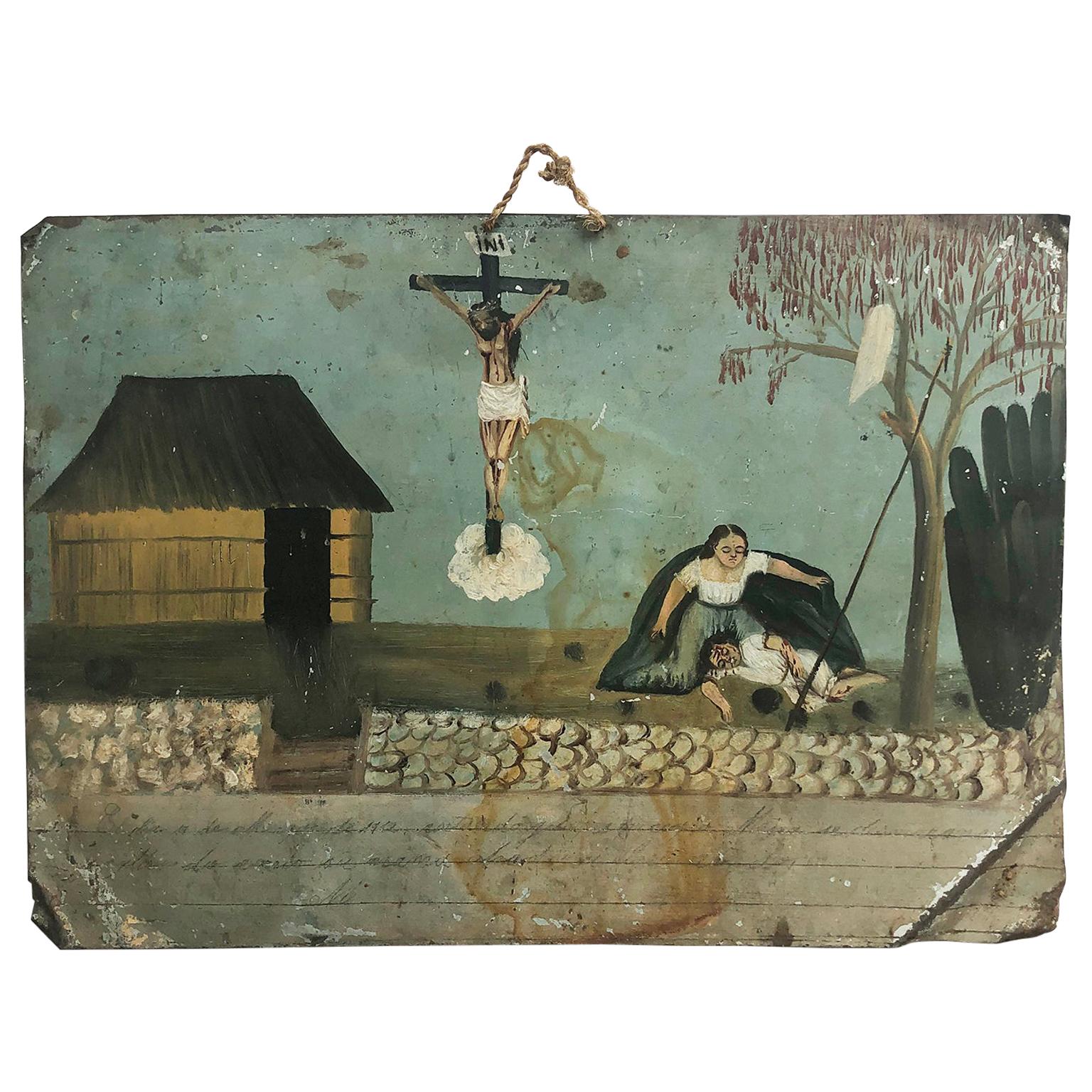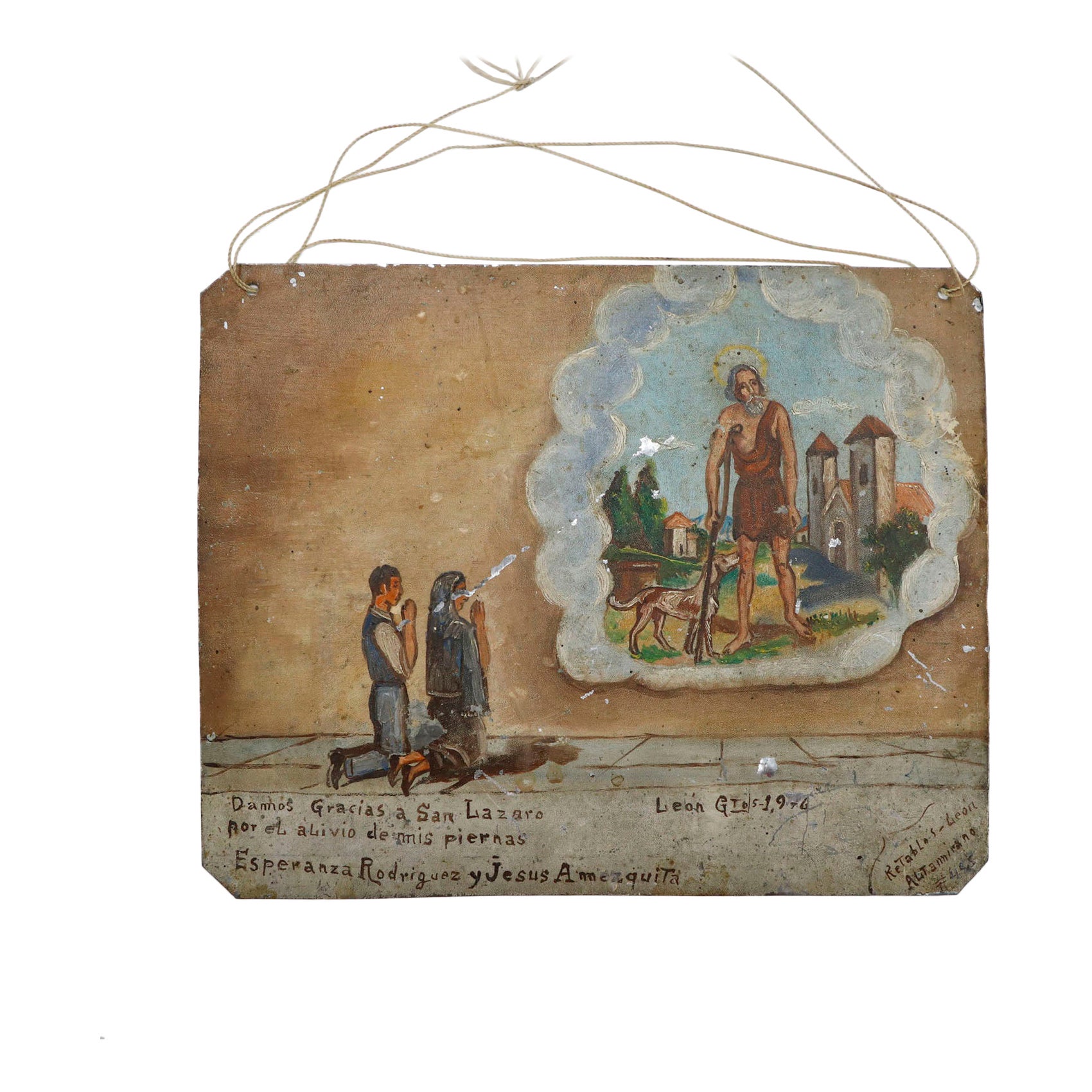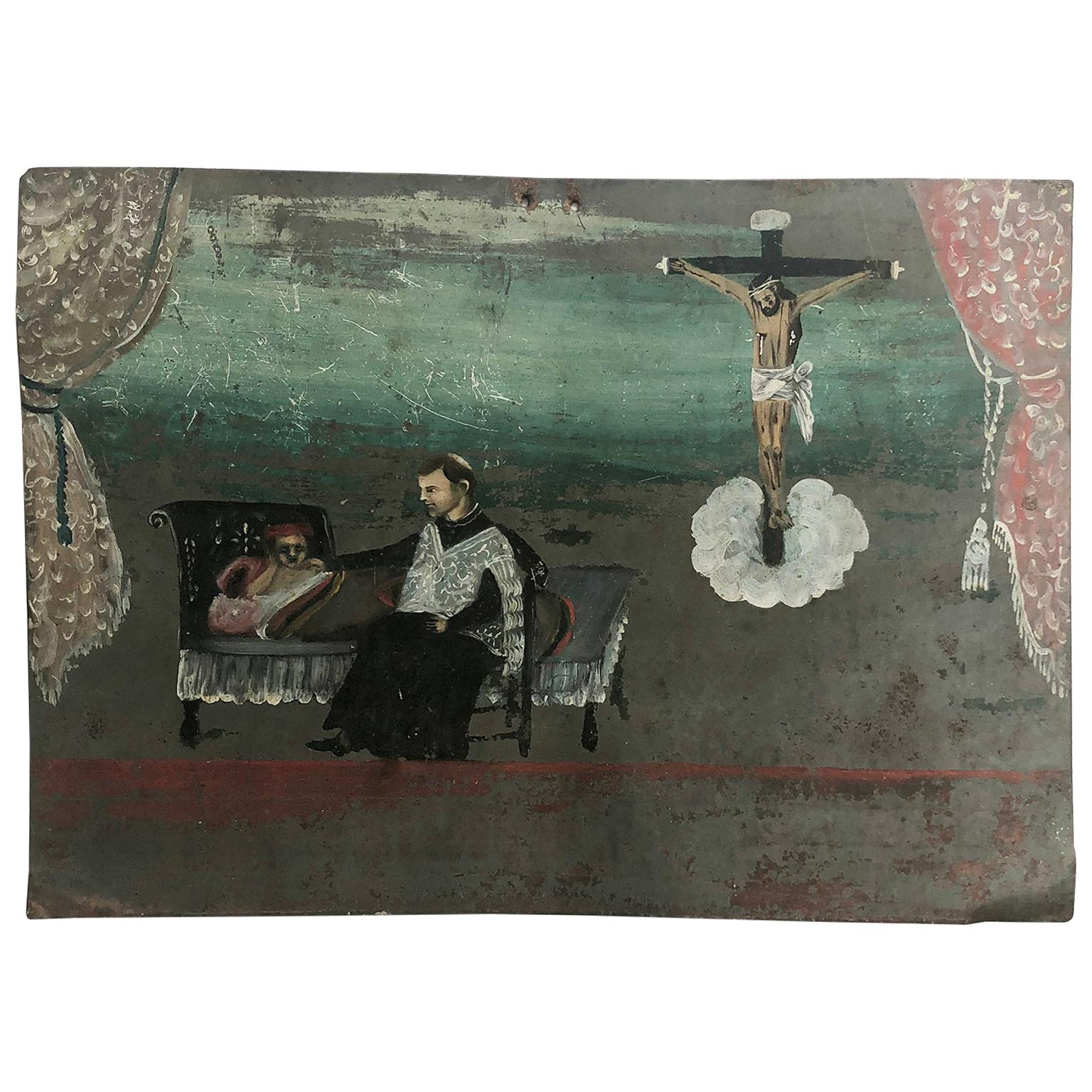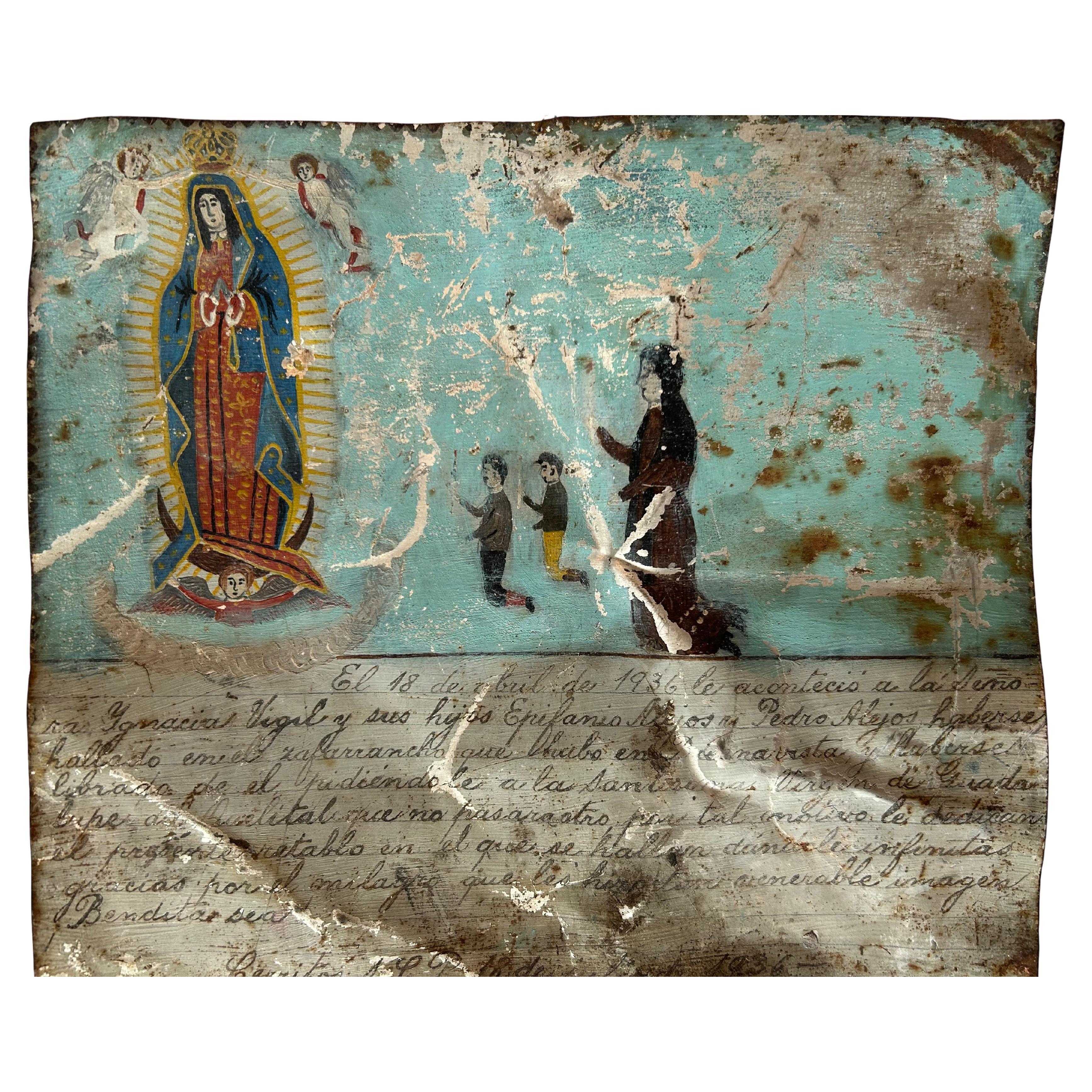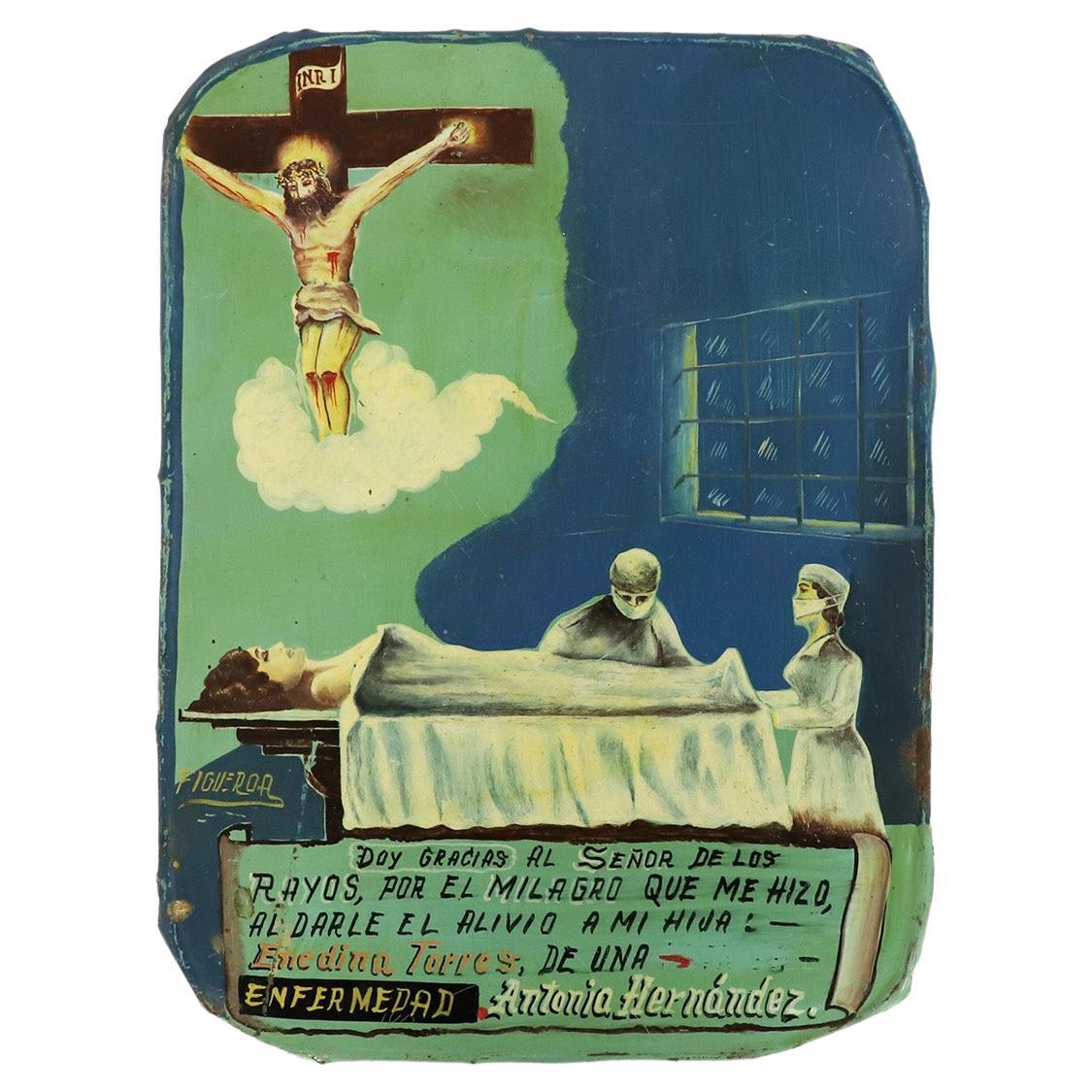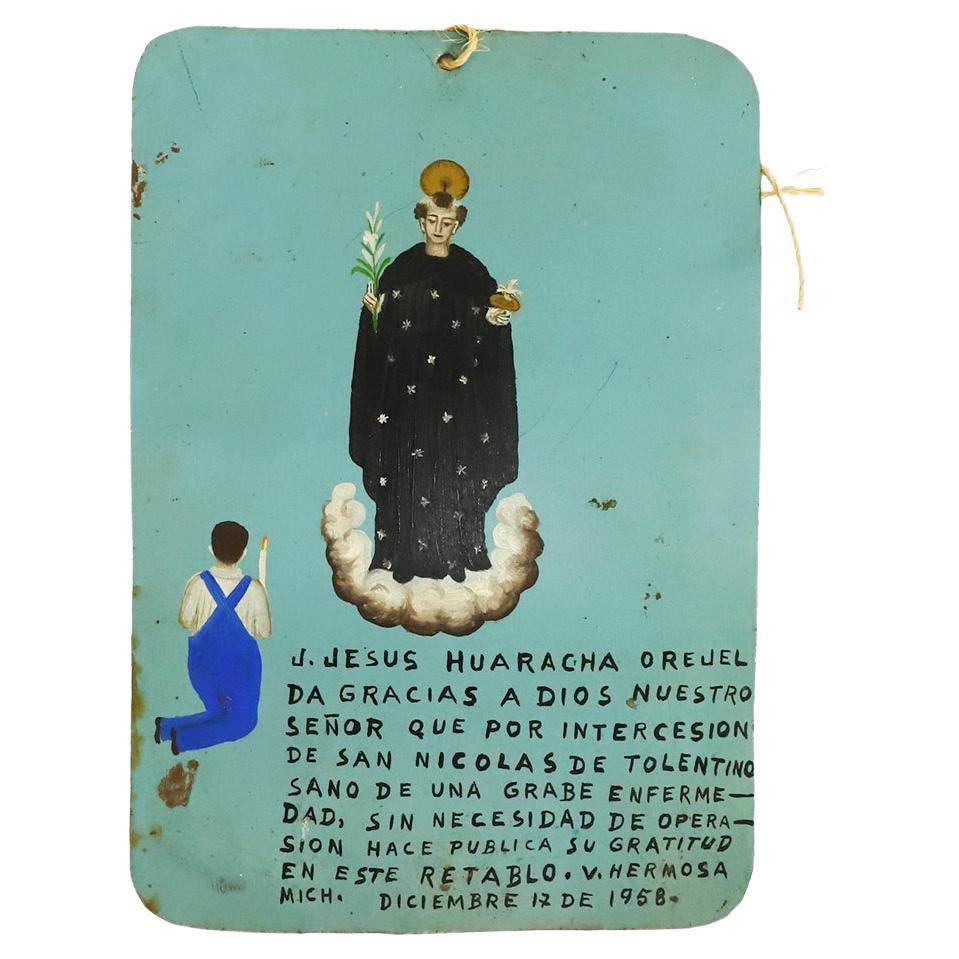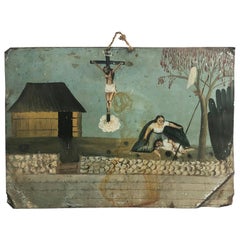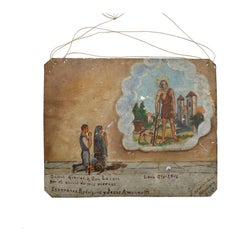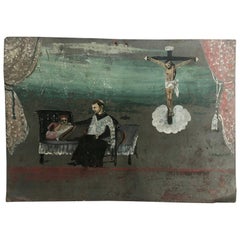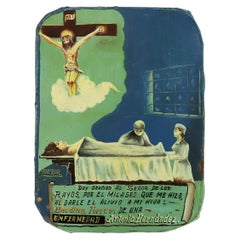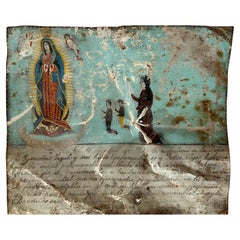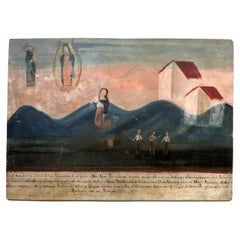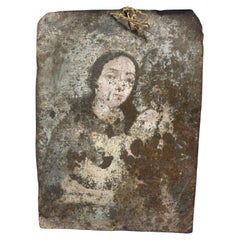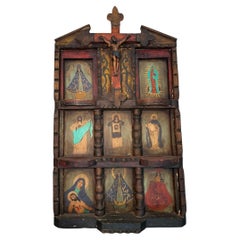Items Similar to Original Mexican Retablo "Exvotos" Oil on Tin
Want more images or videos?
Request additional images or videos from the seller
1 of 6
Original Mexican Retablo "Exvotos" Oil on Tin
$600
£458.73
€528.37
CA$840.78
A$938.66
CHF 491.84
MX$11,490.07
NOK 6,246.40
SEK 5,889.56
DKK 3,943.25
Shipping
Retrieving quote...The 1stDibs Promise:
Authenticity Guarantee,
Money-Back Guarantee,
24-Hour Cancellation
About the Item
Circa 1950.We offer this original exvoto.
Votive paintings in Mexico go by several names in Spanish such as “ex voto,” “retablo” or “lámina,” which refer to their purpose, place often found, or material from which they are traditionally made respectively. The painting of religious images to give thanks for a miracle or favor received in this country is part of a long tradition of such in the world. The offering of such items has more immediate precedence in both the Mesoamerican and European lines of Mexican culture, but the form that most votive paintings take from the colonial period to the present was brought to Mexico by the Spanish. As in Europe, votive paintings began as static images of saints or other religious figures which were then donated to a church. Later, narrative images, telling the personal story of a miracle or favor received appeared. These paintings were first produced by the wealthy and often on canvas; however, as sheets of tin became affordable, lower classes began to have these painted on this medium. The narrative version on metal sheets is now the traditional and representative form of votive paintings, although modern works can be executed on paper or any other medium.
- Dimensions:Height: 7.09 in (18 cm)Width: 19.69 in (50 cm)Depth: 0.12 in (3 mm)
- Style:Folk Art (In the Style Of)
- Materials and Techniques:
- Place of Origin:
- Period:
- Date of Manufacture:1950
- Condition:Wear consistent with age and use.
- Seller Location:Mexico City, MX
- Reference Number:1stDibs: LU4252239582722
About the Seller
5.0
Gold Seller
Premium sellers maintaining a 4.3+ rating and 24-hour response times
Established in 2010
1stDibs seller since 2018
362 sales on 1stDibs
Typical response time: 1 hour
- ShippingRetrieving quote...Shipping from: Mexico City, Mexico
- Return Policy
Authenticity Guarantee
In the unlikely event there’s an issue with an item’s authenticity, contact us within 1 year for a full refund. DetailsMoney-Back Guarantee
If your item is not as described, is damaged in transit, or does not arrive, contact us within 7 days for a full refund. Details24-Hour Cancellation
You have a 24-hour grace period in which to reconsider your purchase, with no questions asked.Vetted Professional Sellers
Our world-class sellers must adhere to strict standards for service and quality, maintaining the integrity of our listings.Price-Match Guarantee
If you find that a seller listed the same item for a lower price elsewhere, we’ll match it.Trusted Global Delivery
Our best-in-class carrier network provides specialized shipping options worldwide, including custom delivery.More From This Seller
View AllOriginal Mexican Retablo "Exvotos" Oil on Tin
Located in Mexico City, CDMX
We offer this original Mexican Retablo "Exvotos" oil on tin, circa 1920.
Category
Vintage 1920s Mexican Folk Art Antiquities
Materials
Metal
$1,400 Sale Price
30% Off
Original Mexican Retablo "Exvotos" Oil on Tin
Located in Mexico City, CDMX
We offer this original Mexican ex voto of San Lazaro saint. Guanajuato México 1958.
Damos gracias a San Lazaro por el alivio de mis piernas.
Esperanza Rodriguez y Jesus Amezquita.
...
Category
Vintage 1940s Mexican Folk Art Religious Items
Materials
Metal
Original Mexican Retablo "Exvotos" Oil on Tin
Located in Mexico City, CDMX
We offer this original Mexican ex voto, due to the effects of time, the writing has been erased.
Category
Vintage 1930s Mexican Folk Art Religious Items
Materials
Metal
$1,050 Sale Price
30% Off
Original Mexican Retablo "Exvotos" Oil on Tin
Located in Mexico City, CDMX
We offer this original Mexican ex voto. Made with oil painting signed by Figueroa.
Category
Vintage 1950s Mexican Folk Art Religious Items
Materials
Metal
Original Mexican Retablo "Exvotos" Oil on Tin
Located in Mexico City, CDMX
We offer this original Mexican ex voto. Michoacán México 1958
J. Jesus Huaracha Orejel da gracias a dios nuestro señor que por intersección de San Nic...
Category
Vintage 1950s Mexican Folk Art Religious Items
Materials
Metal
19th Century Original Mexican Retablo "Exvoto" Oil on Tin
Located in Mexico City, CDMX
Dated 1870, we offer this 19th century original Mexican retablo "Exvoto" oil on tin, due to the effects of time, the writing has been erased but we can read the nex:
“Le aconteció esta desgracia al niño Monico Rico el día 26 de Diciembre de 1870 que lo tumbo un caballo le quebró una pierna
“This misfortune happened to the child Monico Rico on December 26, 1870, when a horse knocked him down and broke his leg
Votive paintings...
Category
Antique 1870s Mexican Folk Art Religious Items
Materials
Metal
You May Also Like
Antique Mexican Retablo "Exvoto" Oil on Tin, 1936
Located in Toronto, CA
Beautiful Mexican retablo or ex voto, painted in 1936, describing a mother giving thanks to the Virgin for the safety of her two boys. The crowned Virgin of Guadeloupe floats surroun...
Category
Vintage 1930s Mexican Folk Art Decorative Art
Materials
Tin
A Very Good 19th Century Hand Painted Mexican Retablo Dated 1884
Located in Ottawa, Ontario
The naïve, hand painted vignette depicts a woman praying to the images of Saint Anthony holding The Christ Child, together with The Holy Mother, all shown hovering above a group of t...
Category
Antique Late 19th Century Mexican Folk Art Religious Items
Materials
Tin
Colonial Mexican Folk Art Ex-Voto Retablo Painting of Mother Mary & Jesus, 1800s
Located in Studio City, CA
A beautiful 19th-century Spanish Colonial Mexican Folk Art ex-voto retablo lámina painting featuring Mother Mary with the infant Jesus Christ (faded and now almost a ghost-like figur...
Category
Antique 19th Century Mexican Folk Art Paintings
Materials
Metal, Tin
Latin American Religious Folk Art Nicho Retablos Shrine
Located in Guaynabo, PR
This is a Latin American Religious Folk Art Nicho Retablos Shrine. It depicts a rectangular wooden panel shaped as a neoclassical temple, but the center of the pediment is cut to acc...
Category
Late 20th Century Unknown Arts and Crafts Decorative Art
Materials
Wood
Collection of Mexican Prayer Plaques "Retablos Ex-Votos" from 1950s and 1960s
Located in North Miami, FL
This is an amazing and important collection of 8 plaques (7 tin metal and one in wood) that have been hand painted by Catholic religious devotees in gratitude to either Christ, Virgi...
Category
Vintage 1950s Mexican Folk Art Drawings
Materials
Tin
Spanish Colonial Mexican Folk Art Ex-Voto Retablo Painting Catholic Saint 1800s
Located in Studio City, CA
A beautiful 19th-century Spanish Colonial Mexican Folk Art ex-voto retablo lámina painting featuring an unknown Spanish Roman Catholic Saint.
The work is hand-painted on metal (li...
Category
Antique 19th Century Mexican Folk Art Paintings
Materials
Metal, Tin
More Ways To Browse
Folk Religious Art
Mexican Colonial
Mexico Religious
Mexican Colonial Furniture
Folk Art Church
Mexican Spanish Colonial Furniture
Mexico Tin
Ex Voto
Mexican Colonial Painting
Mexican Retablo
Spanish Retablo
Religious Retablos
Mexican Votives
Mexican Retablo Oil On Tin
Oil Paintings Spanish Colonial Saints
Spanish Colonial Retablos
1940s Modern Furniture
Vintage Furniture Labels
